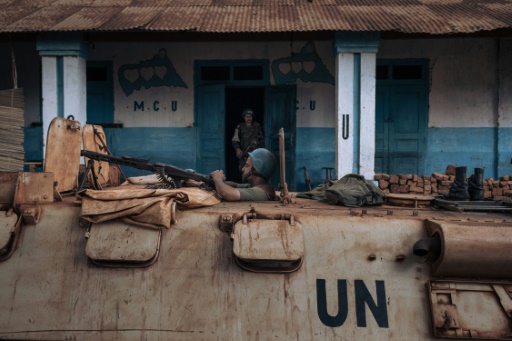
[ad_1]
When the rebels arrived in the town of Bangassou, in the Central African Republic, the region’s main official, Pierrette Benguere, was forced to take refuge at a UN base for a month.
Today, Bangassou, which once housed around 30,000 people, is a ghost town, its symbolic fate not only of the recent rebellion, but also of a long-standing struggle to reaffirm the presence of the state in a country where the most of the territory is lawless.
In order for Benguere to address the inhabitants of Bangassou, the capital of Mbomou prefecture of which she is the main representative, she did not go to the city, but to the forest that surrounds her.
Thousands of families who fled the violence have dug there, cutting branches to weave shelters in the forest about 700 kilometers (435 miles) east of the capital Bangui.
They are among 200,000 people displaced after six of the 14 armed groups that control two-thirds of the country reneged on a peace pact with President Faustin Archange Touadera in mid-December.
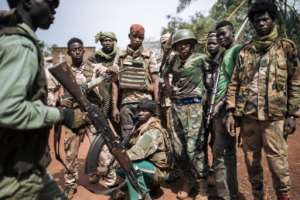 Six armed groups joined forces and launched an offensive, vowing to disrupt the December elections and march on the capital. By ALEXIS HUGUET (AFP)
Six armed groups joined forces and launched an offensive, vowing to disrupt the December elections and march on the capital. By ALEXIS HUGUET (AFP) The six armed groups joined forces and launched an offensive, pledging to disrupt the December elections and march on the capital in what the government called a coup attempt.
But the rebels were unable to prevent Touadera from being re-elected in the December 27 vote, in which not even one in two voters was able to vote due to insecurity.
On January 3, several hundred heavily armed men attacked government troops in Bangassou. They also attacked the highly skilled paramilitary forces of the Russian private security company Wagner.
Moscow, which supports Touadera, flew in reinforcements at the end of December, while Rwanda also sent troops to bolster the poorly equipped and trained Central African army.
‘In the middle of the battle’
After several hours of fighting in Bangassou, on January 3, the UN MINUSCA mission joined the fray to bring the wounded, the unharmed and the city leaders to the safety of the UN base.
There, they found Benguere, who had taken refuge in the base a week earlier.
Earlier this month, the official was escorted by MINUSCA armored vehicles when she visited displaced families in the forest outside Bangassou.
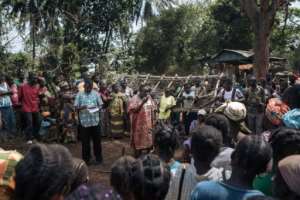 Pierrette Benguere, head of the Mbomou prefecture, addresses people displaced from Bangassou by the violence. By ALEXIS HUGUET (AFP)
Pierrette Benguere, head of the Mbomou prefecture, addresses people displaced from Bangassou by the violence. By ALEXIS HUGUET (AFP) “We are in the midst of a fight and MINUSCA is not going to abandon me,” Benguere told those gathered around her during the visit.
“Whether they like it or not, the rebels will eventually leave the area.”
We cannot fault some of those who listen for not being totally convinced.
Bangassou’s fate reflects what has happened to many towns in CAR since the outbreak of the civil war in 2013.
Armed groups exercise control over vast areas of the great nation’s land covered with forests and savannah.
The state tries to maintain enclaves with a semblance of administrative, police and judicial authority through a handful of officials who have to live and deal with rebel forces.
When a problem arises, government personnel take refuge at the MINUSCA base.
The rebels withdrew from Bangassou on January 15 after an ultimatum from MINUSCA, but they remain ubiquitous in the bush and in the villages, while controlling the roads.
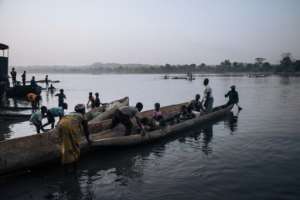 Central Africans displaced from their homes have had to find a new way of life. By ALEXIS HUGUET (AFP)
Central Africans displaced from their homes have had to find a new way of life. By ALEXIS HUGUET (AFP) A self-proclaimed general, Mahamat Saleh, commands a unit of several dozen fighters locked in the village of Niakari.
The village is deserted, like all the neighboring colonies since the arrival of the rebels.
“We are not here to attack the population,” Saleh said in an interview in January, dressed in civilian clothes but surrounded by heavily armed youths.
“We attacked Bangassou because President Touadera sold the Central African Republic,” he said, adding that the rebels had a key objective: “Touadera’s resignation”.
‘Crackling gunshots’
In villages like Niakari, shops, schools and health centers are closed. The militia fighters carrying their weapons frighten the villagers.
“If they do not leave these places, it will be difficult to resume lessons. If the children stay at home, it will be the rebels of tomorrow that we are going to do,” warns Prefect Benguere.
Victoire Ngokpou, psychologist at Bangassou hospital, has decided to take her family to safety on the opposite bank of the Mbomou River in the Democratic Republic of the Congo.
She rents a room in a mud house surrounded by a refugee camp.
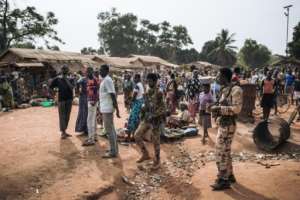 Armed groups exercise control over vast areas of the great nation’s land covered in forests and savannah. By ALEXIS HUGUET (AFP)
Armed groups exercise control over vast areas of the great nation’s land covered in forests and savannah. By ALEXIS HUGUET (AFP) “But some of my colleagues at the hospital are crammed into shelters made of plastic sheeting, with more than 15 people,” she said.
Every morning, she crosses the river to return to CAR by canoe, then climbs on a motorbike under the surveillance of Moroccan UN troops on guard at the border post.
Once at the hospital, supported by Médecins sans frontières, Victoire finds her office surrounded by displaced people in search of protection.
“A large number of people have lost their property, their loved ones,” said the psychologist.
“And then too, hearing the crackle of gunshots, some people just can’t stand it.”
Source link